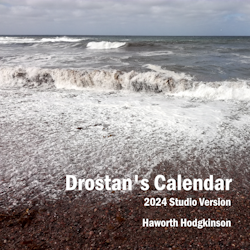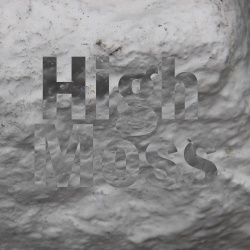
Drostan's Calendar
Music by Haworth Hodgkinson
High Moss HM 030 (55:40) • Released 31 December 2024
Music composed, performed and recorded by Haworth Hodgkinson, 2004–2024
Cover from a photograph by Haworth Hodgkinson
Album © Haworth Hodgkinson 2024
Links: Haworth Hodgkinson • Intuitive Music Aberdeen
Buy album via Bandcamp (secure)
Drostan's Calendar (2024 Studio Version)
[00:00] January
[05:00] February
[09:33] March
[14:05] April
[18:30] May
[22:59] June
[27:29] July
[31:57] August
[36:33] September
[41:03] October
[45:33] November
[50:07] December
The twelve sections of Drostan's Calendar play continuously without pause, so I have presented them as a single track to avoid the playback interruptions that would be caused by track breaks on some popular audio formats. The timings above give a guide to the beginning of each section.
Drostan's Calendar
Drostan's Calendar is a piece I have worked on for many years and which feels particularly significant to me, so it seems appropriate to release a studio recording of this piece in 2024, the year of my 60th birthday, as well as the 20th anniversary of the field recordings that form the backbone of the piece. This album is also the 30th release on High Moss, so that's another milestone of sorts!
According to accounts in the Book of Deer and the Aberdeen Breviary, Drostan accompanied Columba when he sailed from Ireland to Scotland in about 563 AD. They landed at Aberdour on the north coast of Aberdeenshire and established a monastery in Buchan at a bend in the River Ugie. Archaeologists debate the exact location of this monastery, but it is believed to lie somewhere in the vicinity of Old Deer, perhaps on the site of the more recent Deer Abbey, or within what is now Aden Country Park.
Columba returned to Iona, but Drostan remained in the North-East, and his name is associated with various sites in Aberdeenshire and Angus. The pebble beach at Aberdour where he first landed is sometimes known as the Drostan Shore. The Pictish symbol stone at St Vigeans known as the Drosten Stone, unusual in bearing an inscription in Roman script, "drosten ipeuoret ettfor cus", probably refers to the same person. Drostan ended his days as a hermit in Glen Esk, and after his death his relics were taken back to Aberdour.
The idea for my piece Drostan's Calendar goes back 25 years to late December 1999, when I made a recording of the sea crashing on the pebbled shore where Drostan first landed. This recording became the basis of Winter Sea, which can be heard on the album Year's Embers. But I also had the idea to make multiple recordings in this location over the course of a year, charting the seasonal changes of mood and atmosphere. I did this in 2004, visiting and recording every month for the whole year. I knew I wanted to make some sort of extended piece, or series of pieces, using these twelve monthly recordings, but it wasn't until 2015 that I worked out how that piece might be constructed. The music plays continuously for about an hour, with around five minutes for each month. The twelve recordings of the shoreline are filtered to bring out certain pitches, over which live musicians play intuitively in a sequence of modes based on the same pitches. These modes gradually increase in complexity, from sparse occasional utterances of a single pitch in January, two pitches in February, through to a pentatonic mode in May, something close to a Lydian mode in July, and a fully chromatic mode of twelve pitches in December. The transitions from one month to the next, when the mode changes as well as the weather, are quite sudden and dramatic, perhaps most strikingly when the fierce and stormy September gives way to the calm but energy-drained October.
The piece was developed in a series of performances with the ensemble Intuitive Music Aberdeen playing keyboards. I intended to remake the field recordings over the course of 2020, but circumstances in that year took various unexpected turns and I had to abandon that plan. Instead, I remade the backing in 2022, still using the original 2004 recordings but cleaning them up a little and tightening the transitions between the months. This revised version was first played by Intuitive Music Aberdeen at Mannofield Parish Church, Aberdeen, in September 2022, when the Book of Deer, normally kept in the Cambridge University Library, was on temporary display in Aberdeen. This version became the basis of the 2024 studio recording that you hear on this album, in which I play four separate multi-tracked keyboard parts.
In the event, 2024 brought with it some unexpected twists. The artistic community of North-East Scotland arranged a few lovely events to mark my 60th birthday, although circumstances conspired to disrupt the celebrations – a week before my birthday I became an orphan, then illness and injury confined me to home for most of the latter part of the year. At least this confinement enabled me to spend the time completing this recording!
Notes © Haworth Hodgkinson 2024
